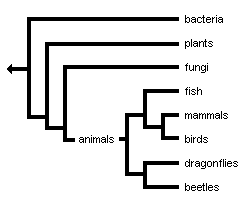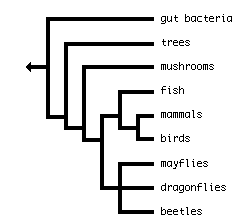Interpreting the Tree Diagram or List of Subgroups on a Tree of Life Page
Most Tree of Life branch pages feature a tree diagram that shows the relationships between the subgroups of the group that the page is about. The root of this tree connects the subgroups to their containing group and the rest of the Tree of Life. The basal branching point in the tree represents the ancestor of the other groups in the tree. This ancestor diversified over time into several descendent subgroups, which are represented as internal nodes and terminal taxa to the right.

For example, consider the following tree:

This phylogeny shows only a few of the many millions of living species, and it is therefore far from complete, but it is useful for this example. This phylogeny states that there was an ancestral species that split to give rise (billions of years later) on the one hand to bacteria, and on the other to multi-celled organisms we see today. The multi-celled lineage split again, and again, diversifying into numerous forms. The phylogeny states that there was an ancestral species that gave rise to mammals and birds, but not to the other species shown in the tree (that is, mammals and birds share a common ancestor that they do not share with other species on the tree), that all animals are descended from an ancestor not shared with fungi, plants, and bacteria, and so on.
For definitions of the terms used in the description of trees, refer to the Tree of Life Glossary. To learn more about the theoretical concepts underlying phylogenetic trees, please visit our Phylogenetic Biology pages and check out the Understanding Phylogenies section of the Understanding Evolution web site.
The trees on ToL pages feature formatting options to express a number of different concepts:
- Grey tree diagrams
- Polytomies
- Groups that may not be monophyletic
- Groups that are not monophyletic
- Groups of uncertain phylogenetic position
- Groups that are extinct
- Labelled branches
- Lists of subgroups
Grey tree diagrams
Some Tree of Life pages have their trees printed in a lighter color. Such lighter trees characterize temporary or skeleton pages which generally have little content. They have been created to serve as links connecting more complete pages. grey trees should be interpreted with caution, because they are usually taken from the literature with little critical evaluation by Tree of Life authors, editors, or peer-reviewers.

Polytomies
The phylogeny shown above is dichotomous, in that at all branch points there are two immediate descendents. If there are more than two immediate descendents at a given branch, then the tree is polytomous. For example, in the following tree, there is a polytomy from which dragonflies, mayflies, and beetles arise, indicating that the relationships between these three lineages is not yet clear:

We don't know if dragonflies and mayflies are more closely related to each other than either is to beetles, or whether beetles are more closely related to mayflies, or beetles to dragonflies.
Groups that may not be monophyletic
Branches that are a represented by a hatched line rather than one solid bar indicate that the monophyly of the group may be uncertain. In the following tree, group A may not be monophyletic, indicating that one of Group A's subgroups may be more closely related to group B than to other subgroups of Group A.
![]()
Groups that are not monophyletic
Branches that are a group of three lines rather than one solid bar indicate that the group is not monophyletic. Generally, we try to avoid non-monophyletic groups in the Tree of Life. However, we sometimes need to work with them, if we want to divide the diversity of a large group into manageable pieces in the absence of phylogenetic hypotheses. In the following tree, group A is non-monophyletic, indicating that Group B's closest relative is actually a subgroup of Group A, but we don't know which subgroup that is.
![]()
Groups of uncertain phylogenetic position
Branches that begin with a question mark indicate that the phylogenetic position of a group is uncertain (incertae sedis). In the following tree, Group C is thought to be the sister group of Group D, but this hypothesis is considered to be preliminary. Group E is thought to belong to the group treated on this page, but there are currently no good hypotheses for the subgroup's position within the group.

Groups that are extinct
If a group does not have any living representatives, i.e., members of the
group are known only from the fossil record, the name of the group is
followed by an extinct icon ![]() .
In the following tree, Group A is entirely extinct; while both Group B
and Group C have at least some subgroups that are alive today.
.
In the following tree, Group A is entirely extinct; while both Group B
and Group C have at least some subgroups that are alive today.

Labelled branches
On some ToL pages, the tree may have one or more labelled branches. The name printed on the branch is that of the group associated with the node (branching point) at the end (i.e., to the right) of the branch. In the following tree, Group B is the sister group of Group A, and it contains both Group C and Group D.

On the Tree of Life, branch labels are used to indicate group names that are noteworthy, eventhough that particular group does not have its own Tree of Life page.
Lists of subgroups
If the phylogenetic relationships among the subgroups of a group are unknown, the Tree of Life page will show list of subgroups instead of a tree. On most ToL pages, this is just a plain list of group names, but some authors provide additional information in the form of an indented list. In the following list, the cascading indentations indicate the names of groups of decreasing inclusiveness: The group treated on this ToL page has three immediate subgroups: Group A, B and E. The subgroups of Group A will be treated on a separate ToL page, but the subgroups of the other two groups are listed on the current page: Group B has two subgroups, Group C and D. Group E has three subgroups, Group F, J, and M.
- Group A
- Group B
- Group C
- Group D
- Group E
- Group F
- Group J
- Group M
If there are any non-monophyletic groups or groups of uncertain phylogenetic position (incertae sedis) included in a classification, these groups are labelled with parenthetical remarks:
- Group A (non-monophyletic)
- Group B (incertae sedis)
 Go to quick links
Go to quick search
Go to navigation for this section of the ToL site
Go to detailed links for the ToL site
Go to quick links
Go to quick search
Go to navigation for this section of the ToL site
Go to detailed links for the ToL site